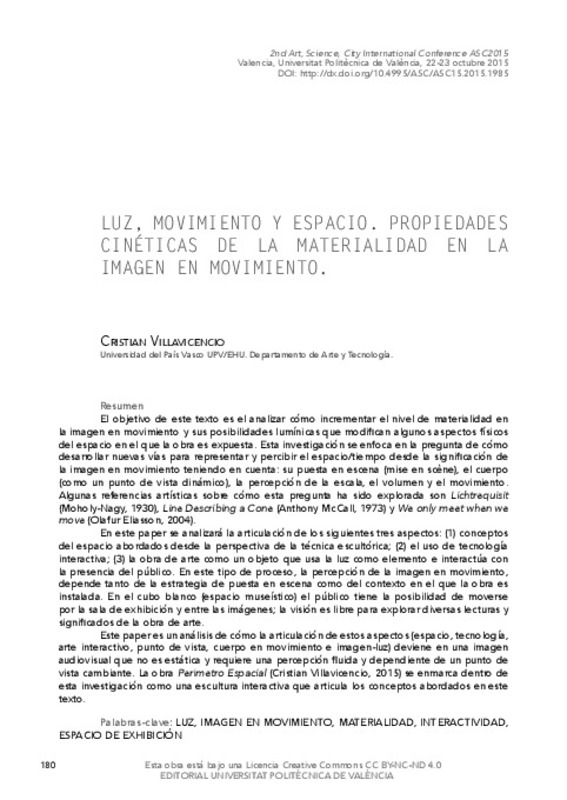JavaScript is disabled for your browser. Some features of this site may not work without it.
Buscar en RiuNet
Listar
Mi cuenta
Estadísticas
Ayuda RiuNet
Admin. UPV
LUZ, MOVIMIENTO Y ESPACIO. PROPIEDADES CINÉTICAS DE LA MATERIALIDAD EN LA IMAGEN EN MOVIMIENTO
Mostrar el registro sencillo del ítem
Ficheros en el ítem
| dc.contributor.author | Villavicencio, Cristian
|
es_ES |
| dc.date.accessioned | 2017-07-20T09:24:16Z | |
| dc.date.available | 2017-07-20T09:24:16Z | |
| dc.date.issued | 2015-11-17 | |
| dc.identifier.isbn | 9788490484562 | |
| dc.identifier.uri | http://hdl.handle.net/10251/85527 | |
| dc.description.abstract | [EN] The objective of this paper is to analyze how to increase the level of materiality of the moving image and it’s lighting qualities that can modify aspects of the environment in which the artwork is installed. This research addresses the question of how to develop new ways to represent and perceive the time/space from the significance of the moving image taking into consideration: the installation of the artwork (mise en scène), the body (as a floating point of view), scale perception, volume and movement. Some references of how these questions have been explored are Lichtrequisit (Moholy-Nagy, 1930), Line Describing a Cone (Anthony McCall 1973) and We only meet when we move (Olafur Eliasson, 2004). In this paper I will analyze how the articulation of 3 aspects can be explored: (1) the concept of space treated from the perspective of sculpture; (2) the use of interactive technology (3) the installation of the artwork as an object that use light and interact with the presence of the public. In this kind of process, perception of moving images depends on how these images are displayed and the context where the artwork is installed. In a ‘white cube’, people are able to move freely through the exhibition space and between the images; vision is free to explore different readings and meanings of the artwork. The presentation will offer an analysis of how the articulation of these aspects (space, technology, interactive artwork, point of view, moving body and light images) resulting in a kind of image which perception is fluid, and dependent on a moving point. The artwork Space Perimeter (Cristian Villavicencio, 2015) is part of this research as an interactive sculpture that articulates de concepts that are mentioned in this text | es_ES |
| dc.description.abstract | [ES] El objetivo de este texto es el analizar cómo incrementar el nivel de materialidad en la imagen en movimiento y sus posibilidades lumínicas que modifican algunos aspectos físicos del espacio en el que la obra es expuesta. Esta investigación se enfoca en la pregunta de cómo desarrollar nuevas vías para representar y percibir el espacio/tiempo desde la significación de la imagen en movimiento teniendo en cuenta: su puesta en escena (mise en scène), el cuerpo (como un punto de vista dinámico), la percepción de la escala, el volumen y el movimiento. Algunas referencias artísticas sobre cómo esta pregunta ha sido explorada son Lichtrequisit (Moholy-Nagy, 1930), Line Describing a Cone (Anthony McCall, 1973) y We only meet when we move (Olafur Eliasson, 2004). En este paper se analizará la articulación de los siguientes tres aspectos: (1) conceptos del espacio abordados desde la perspectiva de la técnica escultórica; (2) el uso de tecnología interactiva; (3) la obra de arte como un objeto que usa la luz como elemento e interactúa con la presencia del público. En este tipo de proceso, la percepción de la imagen en movimiento, depende tanto de la estrategia de puesta en escena como del contexto en el que la obra es instalada. En el cubo blanco (espacio museístico) el público tiene la posibilidad de moverse por la sala de exhibición y entre las imágenes; la visión es libre para explorar diversas lecturas y significados de la obra de arte. Este paper es un análisis de cómo la articulación de estos aspectos (espacio, tecnología, arte interactivo, punto de vista, cuerpo en movimiento e imagen-luz) deviene en una imagen audiovisual que no es estática y requiere una percepción fluida y dependiente de un punto de vista cambiante. La obra Perímetro Espacial (Cristian Villavicencio, 2015) se enmarca dentro de esta investigación como una escultura interactiva que articula los conceptos abordados en este texto. | es_ES |
| dc.format.extent | 5 | es_ES |
| dc.language | Español | es_ES |
| dc.publisher | Editorial Universitat Politècnica de València | es_ES |
| dc.relation.ispartof | Actas Segundo Congreso Internacional Arte Ciencia Ciudad ACC2015 | es_ES |
| dc.rights | Reconocimiento - No comercial - Sin obra derivada (by-nc-nd) | es_ES |
| dc.subject | Arte | es_ES |
| dc.subject | Ciencia | es_ES |
| dc.subject | Ciudad | es_ES |
| dc.subject | Visualidad | es_ES |
| dc.subject | Energía | es_ES |
| dc.subject | Conectividad | es_ES |
| dc.subject | Luz | es_ES |
| dc.subject | Oscuridad | es_ES |
| dc.title | LUZ, MOVIMIENTO Y ESPACIO. PROPIEDADES CINÉTICAS DE LA MATERIALIDAD EN LA IMAGEN EN MOVIMIENTO | es_ES |
| dc.type | Capítulo de libro | es_ES |
| dc.type | Comunicación en congreso | es_ES |
| dc.rights.accessRights | Abierto | es_ES |
| dc.description.bibliographicCitation | Villavicencio, C. (2015). LUZ, MOVIMIENTO Y ESPACIO. PROPIEDADES CINÉTICAS DE LA MATERIALIDAD EN LA IMAGEN EN MOVIMIENTO. En Actas Segundo Congreso Internacional Arte Ciencia Ciudad ACC2015. Editorial Universitat Politècnica de València. 181-185. http://hdl.handle.net/10251/85527 | es_ES |
| dc.description.accrualMethod | OCS | es_ES |
| dc.relation.conferencename | 2º Congreso Internacional ACC: Arte, Ciencia, Ciudad | es_ES |
| dc.relation.conferencedate | October 22-23,2015 | es_ES |
| dc.relation.conferenceplace | Valencia, Spain | es_ES |
| dc.relation.publisherversion | http://ocs.editorial.upv.es/index.php/ASC/ASC15/paper/view/2036 | es_ES |
| dc.description.upvformatpinicio | 181 | es_ES |
| dc.description.upvformatpfin | 185 | es_ES |
| dc.type.version | info:eu-repo/semantics/publishedVersion | es_ES |
| dc.relation.pasarela | OCS\2036 | es_ES |






